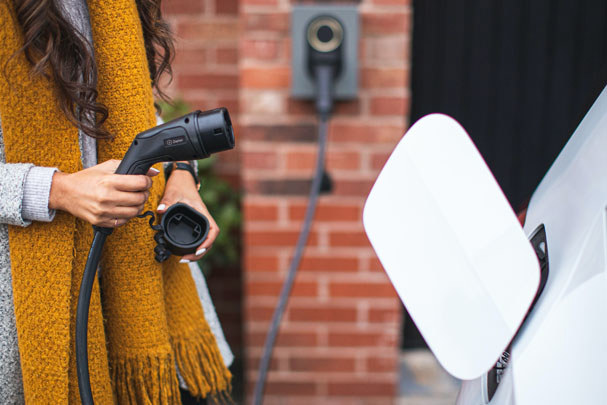
Nationwide Vehicle Contracts advises EV drivers on smart charging practices and their impact on maximising miles per kWh.
Electric vehicles (EVs) have gained popularity with motorists thanks to their eco-friendly nature and cost savings. However, one thing that many prospective EV drivers don't consider is charging.
It's essential that you know how to charge your EV and adopt efficient charging strategies that will help maximise your EV range.
In this blog, we'll focus on smart charging practices and delve into charging methods to help you make the most of your EV.
Home Charging
Home charging is what you'll be doing the most, with around 80% of EV owners currently charging at home (ZapMap). It's most important if you plan on using your EV for your daily commute. You'll need to charge your car overnight to ensure it's fully operational in the morning.
Follow these steps to ensure your home charging is as efficient as possible:
Choose the Right Charging Infrastructure
There are two home charging options available in the UK, a 3kW or a 7kW charger. 3kW chargers let you charge from a standard home socket, and although they're slow, they are energy efficient.
7kW chargers are perfect for home charging and usually charge your EV in about seven hours. It's worth noting that you'll have to pay installation costs for 7kW chargers.
Time Your Charging
To optimise home charging efficiency, schedule charging during off-peak hours such as overnight.
Maintain Battery Health
Home charging is great for keeping your battery in good condition and thus maintaining its efficiency. Whereas fast charging leads to battery degradation, home charging is perfect for keeping your battery within the recommended state-of-charge range (20-80%). This will keep your range as high as possible while keeping charging costs down.
Public Charging
If you don't have a home charger, which is common for those without driveways, the next port of call is public charging. Like petrol stations, public EV charging facilities are being set up across the UK, allowing EV drivers to charge their cars and then move on.
Simply turn up, authenticate yourself as a user, and then pay for your charging.
There are several ways you can maximise using public charging:
Research Charging Locations
When planning routes for long journeys, research and locate public charging stations along the way. There are plenty of resources available, such as ZapMap, that use real-time information on charging station availability and pricing.
By planning a route with charging stations, you can ensure your battery remains within 20-80% charge, which is where it's most efficient. You'll also help alleviate range anxiety, which is a problem most EV drivers suffer with.
Utilise Charging Network
Consider joining EV charging networks, which offer convenient access to various charging stations. Some networks provide member benefits, such as discounted rates or exclusive access.
You'll also be able to maximise your miles per kWh as you're more likely to find charging options wherever you go, reducing range anxiety and allowing you to charge on the go. Also, as charger networks are private, they reduce the chances of encountering unreliable charging equipment, contributing to a smoother and more efficient experience.
Optimise Charging Speed
Finally, select the charging speed that suits your needs. This will save you money and maximise efficiency.
If you're stopping over for a long time, such as at a shopping centre, use a slow charger that will gradually charge your car. Reserve rapid chargers for quick top-ups during road trips or if you're in a rush.
Fast Charging
Rapid charging is reserved for when you need it most. Unlike when driving a combustion engine car, you simply can't fill up your EV within a matter of minutes and drive off. It takes at least 20 minutes, even when using a rapid charger, so you still need to plan to maximise efficiency.
Plan Fast Charging Stops
Like public charging, ensure you've planned your route to feature fast charging stations along the way. If you're in a rush, you can plug in and drive away in around 30 minutes (depending on your car's charging capabilities).
Aim to plug in when your battery is at a lower charger, typically around 20-30%, to maximise fast charging.
Avoid Overusing Fast Charging
While fast charging is convenient, excessive use can lead to increased wear and tear on your battery. Reserve fast charging for when you need it most to help maximise the lifespan of your battery.
For more information on this, check out our guide on Electric Car Maintenance.
Monitor Charging Speed
During fast charging sessions, keep an eye on the charging speed. As your battery increases in charge, the charging rate may slow down, increasing the length of the charging session.
This is why it's also crucial to plan ahead. If you're in a rush and need a certain amount of miles to get somewhere, the last thing you want is the stress of watching your EV slowly increase in charge.
Plan ahead and consider the length of your charging session to maximise kWh.
Conclusion
Efficient charging practices are essential for getting the most out of your electric vehicle. Remember to follow the steps outlined above, whether charging at home, using public charging stations, or relying on fast chargers.
Keep your EV within 20-80% to maximise battery performance, slow charge whenever possible, and always plan your route accordingly.
These will help contribute to a more sustainable future while keeping a smile on your face when behind the wheel of your EV.
Looking to get behind the wheel of an electric car? Nationwide Vehicle Contracts is one of the UK’s largest car leasing brokers offering a range of lease deals to suit your every need.
We also produce regular guides on electric and hybrid car leasing, such as Electric Car Running Costs and Electric Cars with the Longest Range.

